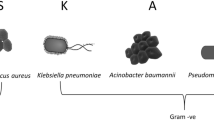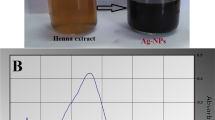Abstract
The rate of drug resistance strains increased drastically over the past several decades, which forced researchers to develop new drugs to treat these pathogens. In the present study by the use of well diffusion method, the antimicrobial activity of Citrus sinensis and its synergism with chitosan modified compound (CMC) were checked. The multidrug resistant bacterial strains Pseudomonas aeruginosa, Escherichia coli, Staphylococcus aureus, vancomycin-resistant Staphylococcus aureus (VRSA), Methicillin-resistant S. aureus (MRSA), Acinetobacter baumannii, VRSA and coagulase negative, and methicillin-resistant and vancomycin sensitive S. aureus were used against the different solvents of C. sinensis (seeds, leaves, stem, juice, fruit peel and C. sinensis peels) i.e. methanol and ethyl acetate to check its anti-MDR activity. Furthermore, methanolic and ethyl acetate extracts were then tagged with CMC and the results were compared. Out of two solvents, the highest activity was shown by ethyl acetate extracts followed by methanolic extracts and the formulation of the C. sinensis and CMC showed even more activity than simple extracts. Ethyl acetate extract of leaves of C. sinensis, tagged with CMC illustrates highest activity zone i.e. 53.3 mm against MDR E. coli while simple ethyl acetate C. sinensis leaf extract against A. baumannii showed the highest inhibition zone of 58.5 mm at the concentration of 100 mg/ml. Consequently, the C. sinensis could be a possible solution against superbugs.








Similar content being viewed by others
References
Ahmad M, Ansari MN, Alam A, Khan TH (2013) Oral dose of citrus peel extracts promotes wound repair in diabetic rats. Pak J Biol Sci 16(20):1086–1094
Ahmad S, Tauseef I, Haleem KS, Khan K, Shahzad M, Ali M, Sultan FJAN (2019) Synthesis of silver nanoparticles using leaves of Catharanthus roseus and their antimicrobial activity. Appl Nanosci. https://doi.org/10.1007/s13204-019-01221-z
Antony R, Arun T, Manickam STD (2019) A review on applications of chitosanbased Schiff bases. Int J Biol Macromol 129:615–633
Arora M, Kaur P (2013) Phytochemical screening of orange peel and pulp. Int J Res Eng Technol 2(12):517–520
Aschoff JK, Kaufmann S, Kalkan O, Neidhart S, Carle R, Schweiggert RM (2015) In vitro bio accessibility of carotenoids, flavonoids, and vitamin C from differently processed oranges and orange juices. J Agric Food Chem 63:578–587
Bajpai O, Pandey J, Chaudhary LB (2016) Ethnomedicinal uses of tree species by Tharu tribes in the Himalayan Terai region of India. Res J Med Plant 10(1):19–41
Deve AS, Kumaresan K, Rapheal VS (2014) Extraction process optimization of polyphenols from Indian Citrus sinensis—as novel antiglycative agents in the management of diabetes mellitus. J Diabetes Metab Disord 13(1):11
Dutta PK, Dutta J, Tripathi VS (2004) Chitin and chitosan: chemistry, properties and applications. J Sci Ind Res 63(1) 20–31
Etebu E, Nwauzoma AB (2014) A review on sweet orange (Citrus sinensis L Osbeck): health, diseases and management. Am J Res Commun 2(2):33–70
Hussain KA, Tarakji B, Kandy BPP, John J, Mathews J, Ramphul V, Divakar DD (2015) Antimicrobial effects of Citrus sinensis peel extracts against periodontopathic bacteria: an in vitro study. RocznikiPaństwowegoZakładuHigieny 66(2):173–178
Karaer H, Kaya İ (2015) Synthesis, characterization, and thermal decompositions of Schiff base polymers containing chitosan unit. Iran Polym J 24(6):471–480
Kelebek H, Selli S (2011) Determination of volatile, phenolic, organic acid and sugar components in a Turkish cv. Dortyol (Citrus sinensis L. Osbeck) orange juice. J Sci Food Agric 91(10):1855–1862
Kölhed M, Karlberg B (2005) Capillary electrophoretic separation of sugars in fruit juices using on-line mid infrared Fourier transform detection. Analyst 130(5):772–778
Li S, Lambros T, Wang Z, Goodnow R, Ho CT (2007) Efficient and scalable method in isolation of polymethoxyflavones from orange peel extract by supercritical fluid chromatography. J Chromatogr B 846(1–2):291–297
Mayaud L, Carricajo A, Zhiri A, Aubert G (2008) Comparison of bacteriostatic and bactericidal activity of 13 essential oils against strains with varying sensitivity to antibiotics. Lett Appl Microbiol 47(3):167–173
Mehmood B, Dar KK, Ali S, Awan UA, Nayyer AQ, Ghous T, Andleeb S (2015) In vitro assessment of antioxidant, antibacterial and phytochemical analysis of peel of Citrus sinensis. Pak J Pharm Sci 28(1):231–239
Nair R, Kalariya T, Chanda S (2005) Antibacterial activity of some selected Indian medicinal flora. Turk J Biol 29(1):41–47
Rani G, Yadav L, Kalidhar SB (2009) Chemical examination of Citrus sinensis flavedo variety pineapple. Indian J Pharm Sci 71(6):677
Rinaudo M (2006) Chitin and chitosan: properties and applications. Prog Polym Sci 31(7):603–632
Saleem M, Farooq A, Ahmad S, Shafiq N, Riaz N, Jabbar A, Malik A (2010) Chemical constituents of Citrus sinensis var. Shukri from Pakistan. J Asian Nat Prod Res 12:702–706
Shetty SB, Mahin-Syed-Ismail P, Shaji Varghese BTG, Kandathil-Thajuraj P, Baby D, Haleem S, Devang-Divakar D (2016) Antimicrobial effects of Citrus sinensis peel extracts against dental caries bacteria: an in vitro study. J Clin Exp Dent 8(1):e71
Soler C, Hamilton B, Furey A, James KJ, Mañes J, Picó Y (2006) Comparison of four mass analyzers for determining carbosulfan and its metabolites in citrus by liquid chromatography/mass spectrometry. Rapid Commun Mass Spectrom 20(14):2151–2164
Vivek KR, Nandin SS, Anitha S (2010) Anti-typhoid activity of aqueous extract of fruit peel Citrus sinensis (L). IJPRD 2(9):31
Author information
Authors and Affiliations
Corresponding authors
Additional information
Publisher's Note
Springer Nature remains neutral with regard to jurisdictional claims in published maps and institutional affiliations.
Rights and permissions
About this article
Cite this article
Fatima, T., Mian, A.H., Khan, Z. et al. Citrus sinensis a potential solution against superbugs. Appl Nanosci 10, 5077–5083 (2020). https://doi.org/10.1007/s13204-020-01408-9
Received:
Accepted:
Published:
Issue Date:
DOI: https://doi.org/10.1007/s13204-020-01408-9




